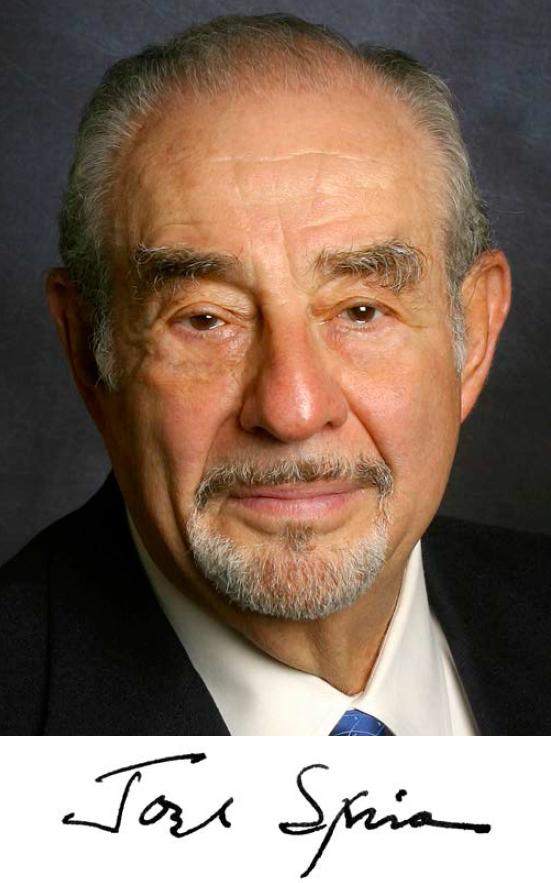JOEL S. SPIRA
1927–2015
Elected in 1994
“For integrating semiconductor technology to lighting products, creating an internationally competitive company, and for continuing work with engineering education.”
BY STEPHEN DIRECTOR AND JOEL MOSES
JOEL SOLON SPIRA, a prodigious innovator who changed the way we illuminate our homes by inventing the first solid state electronic dimmer, and founded and built Lutron Electronics Co., Inc. into a global company selling a wide array of lighting controls, passed away at his home on April 8, 2015, at age 88.
Spira, who was chairman, founder, and director of research, started Lutron in 1961 with his wife Ruth in a spare bedroom of their apartment on the Upper West Side of Manhattan. He used his extraordinary talent for tinkering, engineering, and business to transform the small firm into a highly respected worldwide brand.
Joel was born in New York City on March 1, 1927, to Elias and Edna Spira. After proudly serving in the US Navy from 1944 to 1946, he attended Purdue University and earned a bachelor of science degree in physics in 1948.
At first, he worked for a defense contractor on projects that ultimately led him to think about lighting control—ideas that led to the commercialization of the dimmer for household use. The Capri dimmer was introduced in the early 1960s with ads suggesting that it could enhance the ambiance of a room by “dialing romance.” Today, Lutron makes some 14,000 products that can be found in over 100 countries in residences,
palaces, universities, hotels, museums, and offices, including the Empire State Building.
Joel and Ruth moved the company to Coopersburg, in the Lehigh Valley region of eastern Pennsylvania. Even as Lutron grew into a global company, with sales in more than 100 countries, he continued to run the business with a personal touch. He treated employees like members of his extended family and took time to know people on a personal level.
Lutron was built on and still follows five company principles, by which Joel himself lived: 1. Take care of the customer with superior goods and services. 2. Take care of the company. 3. Take care of the people. 4. Innovate with high-quality products. 5. Deliver value to the customer.
Always looking at things with a “what could be” instead of a “what is” attitude, Joel’s true passion was coming up with new inventions and creative ways of looking at things. He sweated the details, and was committed to precise, dogged attention to the highest quality standards. He didn’t just create something for his own sake or for the money—he wanted to create wealth in society and deliver value. He will be remembered as an entrepreneur and took great pride in everything he did, from working on the early stages of an engineering project, to creating and growing a global business.
Insatiably curious and inquisitive, he was the holder of more than 300 US patents, and under his guidance Lutron expanded its product line from basic, utilitarian dimmer switches to highly advanced and high-tech lighting controls and home automation systems.
Joel led Lutron for 54 years. He also created a company called Subarashii Kudamono (“Wonderful Fruit” in Japanese), a grower and marketer of unique Asian pears, after being introduced to the fruit during his business travels to the Far East.
In 2010 Joel’s accomplishments, inventions, and prominent role in helping develop an entirely new industry dedicated to lighting control were honored when items from Lutron’s 50-year history, including Joel’s first engineering notebook, product prototypes, and early advertising materials, were
donated to the Electricity Collection of the Smithsonian National Museum of Natural History.
He served on a number of advisory boards and councils, and he and Ruth supported education by funding the Ruth and Joel Spira Excellence in Teaching Awards at Carnegie Mellon University, Cornell University, Georgia Institute of Technology, Lehigh University, MIT, Muhlenberg College, Ohio State University, Penn State University, the University of Michigan, the University of Notre Dame, and his own Purdue University. He was a member of the National Academy of Engineering, and a fellow of the Institute of Electrical and Electronics Engineers (IEEE) and American Association for the Advancement of Science (AAAS).
Joel always took time out to do even the smallest things for his community, his company, and his family. He was a contributor to the arts, health care, and education and he was a proud and generous member of Congregation Keneseth Israel of Allentown.
He loved his family and treasured his time with each family member. Wednesday movie night with Ruth was a sacred tradition. He also took tremendous pleasure in the whimsical, such as his watch collection, birdwatching, and his penchant for colorful outfits.
Joel will be remembered as a wonderful, loving husband, father, and grandfather. He is survived by his beloved wife, Ruth Rodale Spira, to whom he was married for 60 years; his sister Miriam Spira Poser; daughters Susan Spira Hakkarainen (husband Pekka Hakkarainen), Lily Spira Housler (husband Ryan Housler), and Juno Spira; and grandsons Ari Hakkarainen, Max Hakkarainen, and Bailey Malanczuk.





